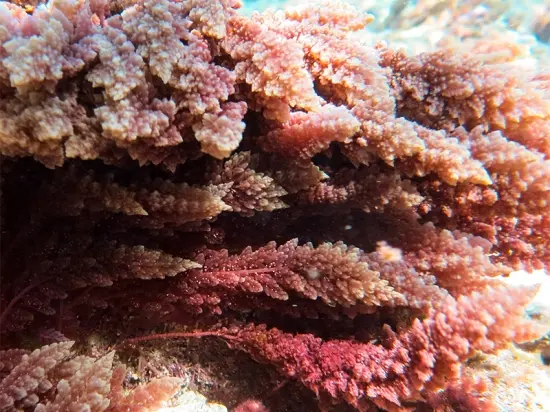
Asparagopsis taxiformis
- Protein
- Antimicrobial[3]
- Antifungal[4]
On Demand weeks

Introduction: Asparagopsis taxiformis
What is Asparagopsis taxiformis?
Asparagopsis taxiformis belongs to the macroalgae and is found worldwide in tropical, warm waters. It is a red algae and therefore not a plant in the conventional sense, as it has no roots, as is the case with terrestrial plants.
Asparagopsis taxiformis has become well known because it offers promising approaches to reducing methane emissions from cows. As methane is one of the biggest problems in greenhouse gas emissions, much research is currently being done to see if Asparagopsis taxiformis can be one of the solutions to this problem[5, 6, 7].
Where is Asparagopsis taxiformis found?
Since Asparagopsis is a macroalgae that is dependent on warm waters, it can only be found and harvested in places like Australia, Mexico, Indonesia and other places with similar ecosystems. This in turn limits producers and traders to these regions.
How to grow Asparagopsis taxiformis?
The red alga Asparagopsis taxiformis can be cultivated in the sea like many other macroalgae. There are different methods. The traditional approach is based on distributing long strands in the sea in the coastal region, which are inoculated with young offshoots of the macroalgae. Over time, the macroalgae grow along the strands, which are then simply pulled out of the water when the kelp is ready for harvesting.
Modern approaches take advantage of floating platforms that float further out to sea, making producers less dependent on limited coastal areas. This also allows experimentation with different depths. Whether traditional or modern, Asparagopsis taxiformis can be grown using either method.
Can humans eat Asparagopsis?
Many species of the genus Asparagopsis are suitable for human consumption. For example, the species Asparagopsis taxiformis is found in traditional foods of Hawaiian culture. Other species of Asparagopsis are also still grown specifically for their effects as dietary supplements and the bioactive substances they contain.
Can you grow Asparagopsis?
The cultivation of macroalgae is simple in principle, but the amount of work involved should not be underestimated. It is physically demanding work that requires a lot of time, and you need access to coastal areas that are suitable for agricultural purposes. In addition, one should always consider and respect the ecosystem. No foreign and potentially invasive species should be introduced into an existing ecosystem if they do not occur there naturally.
Typical applications: Asparagopsis taxiformis
Typical applications
The macroalga Asparagopsis taxiformis belongs to the group of red algae and is mainly found in tropical and warm waters.
Probably the most prominent and relevant opportunity that Asparagopsis taxiformis offers is that it has been shown in studies to drastically reduce methane emissions even in small quantities as part of animal feed for cows[5, 6, 7].
Due to its seasonality, the macroalga Asparagopsis taxiformis is usually abundantly available in the months of March to June.
This product is available in the form of Asparagopsis taxiformis dried whole seaweed.
Sources
- Asparagopsis taxiformis (Delile) Trevisan 1845 - M.D. Guiry in Guiry, M.D. & Guiry, G.M. 01 February 2024. AlgaeBase. World-wide electronic publication, National University of Ireland, Galway. (https://www.algaebase.org/search/species/detail/?species_id=636)
- Asparagopsis taxiformis - Wikipedia (https://en.wikipedia.org/wiki/Asparagopsis_taxiformis)
- Genovese G, Leitner S, Minicante SA, Lass-Flörl C. The Mediterranean red alga Asparagopsis taxiformis has antifungal activity against Aspergillus species. Mycoses. 2013 Sep;56(5):516-9. doi: 10.1111/myc.12065. Epub 2013 Feb 26. PMID: 23437896. (https://pubmed.ncbi.nlm.nih.gov/23437896/)
- Genovese G, Faggio C, Gugliandolo C, Torre A, Spanò A, Morabito M, Maugeri TL. In vitro evaluation of antibacterial activity of Asparagopsis taxiformis from the Straits of Messina against pathogens relevant in aquaculture. Mar Environ Res. 2012 Feb;73:1-6. doi: 10.1016/j.marenvres.2011.10.002. Epub 2011 Oct 21. PMID: 22078751. (https://pubmed.ncbi.nlm.nih.gov/22078751/)
- Indugu N, Narayan K, Stefenoni HA, Hennessy ML, Vecchiarelli B, Bender JS, Shah R, Dai G, Garapati S, Yarish C, Welchez SC, Räisänen SE, Wasson D, Lage C, Melgar A, Hristov AN, Pitta DW. Microbiome-informed study of the mechanistic basis of methane inhibition by Asparagopsis taxiformis in dairy cattle. mBio. 2024 Aug 14;15(8):e0078224. doi: 10.1128/mbio.00782-24. Epub 2024 Jul 2. PMID: 38953639; PMCID: PMC11323727. (https://pubmed.ncbi.nlm.nih.gov/38953639/)
- Roque BM, Venegas M, Kinley RD, de Nys R, Duarte TL, Yang X, Kebreab E. Red seaweed (Asparagopsis taxiformis) supplementation reduces enteric methane by over 80 percent in beef steers. PLoS One. 2021 Mar 17;16(3):e0247820. doi: 10.1371/journal.pone.0247820. PMID: 33730064; PMCID: PMC7968649. (https://pubmed.ncbi.nlm.nih.gov/33730064/)
- Roque BM, Brooke CG, Ladau J, Polley T, Marsh LJ, Najafi N, Pandey P, Singh L, Kinley R, Salwen JK, Eloe-Fadrosh E, Kebreab E, Hess M. Effect of the macroalgae Asparagopsis taxiformis on methane production and rumen microbiome assemblage. Anim Microbiome. 2019 Feb 12;1(1):3. doi: 10.1186/s42523-019-0004-4. PMID: 33499933; PMCID: PMC7803124. (https://pubmed.ncbi.nlm.nih.gov/33499933/)

ALGANEX certificate system
Reply within twelve hours